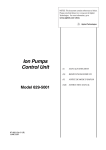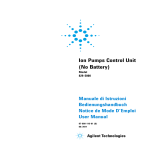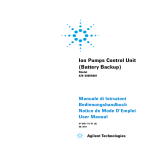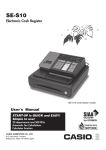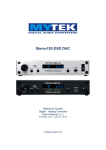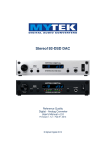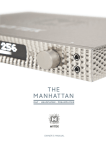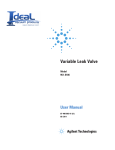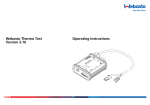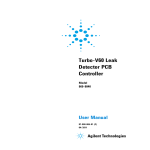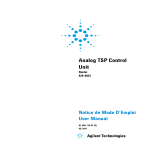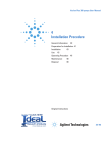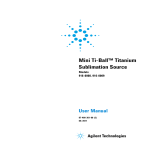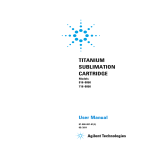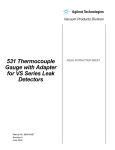Download Ion Pumps Control Unit
Transcript
Ion Pumps Control Unit Model 529-5001R001 User Manual 87-900-128-01 (D) 05/2011 Notices © Agilent Technologies, Inc. 2011 No part of this manual may be reproduced in any form or by any means (including electronic storage and retrieval or translation into a foreign language) without prior agreement and written consent from Agilent Technologies, Inc. as governed by United States and international copyright laws. Manual Part Number Publication Number: 87-900-128-01 (D) Edition Edition 05/2011 Printed in ITALY Agilent Technologies Italia S.p.A. Vacuum Products Division Via F.lli Varian, 54 10040 Leinì (TO) ITALY Warranty The material contained in this document is provided “as is,” and is subject to being changed, without notice, in future editions. Further, to the maximum extent permitted by applicable law, Agilent disclaims all warranties, either express or implied, with regard to this manual and any information contained herein, including but not limited to the implied warranties of merchantability and fitness for a particular purpose. Agilent shall not be liable for errors or for incidental or consequential damages in connection with the furnishing, use, or performance of this document or of any information contained herein. Should Agilent and the user have a separate written agreement with warranty terms covering the material in this document that conflict with these terms, the warranty terms in the separate agreement shall control. Technology Licenses The hardware and/or software described in this document are furnished under a license and may be used or copied only in accordance with the terms of such license. Restricted Rights Legend If software is for use in the performance of a U.S. Government prime contract or subcontract, Software is delivered and licensed as “Commercial computer software” as defined in DFAR 252.227-7014 (June 1995), or as a “commercial item” as defined in FAR 2.101(a) or as “Restricted computer software” as defined in FAR 52.227-19 (June 1987) or any equivalent agency regulation or contract clause. Use, duplication or disclosure of Software is subject to Agilent Technologies’ standard commercial license terms, and nonDOD Departments and Agencies of the U.S. Government will receive no greater than Restricted Rights as defined in FAR 52.227-19(c)(1-2) (June 1987). U.S. Government users will receive no greater than Limited Rights as defined in FAR 52.227-14 (June 1987) or DFAR 252.227-7015 (b)(2) (November 1995), as applicable in any technical data. Trademarks Windows and MS Windows are U.S. registered trademarks of Microsoft Corporation. Safety Notices CAUTION A CAUTION notice denotes a hazard. It calls attention to an operating procedure, practice, or the like that, if not correctly performed or adhered to, could result in damage to the product or loss of important data. Do not proceed beyond a CAUTION notice until the indicated conditions are fully understood and met. WARNING A WARNING notice denotes a hazard. It calls attention to an operating procedure, practice, or the like that, if not correctly performed or adhered to, could result in personal injury or death. Do not proceed beyond a WARNING notice until the indicated conditions are fully understood and met. Ion Pumps Control Unit User Manual / 87-900-128-01 (D) Ion Pumps Control Unit Ion Pumps Control Unit Ion Pumps Control Unit User Manual / 87-900-128-01 (D) 3/58 Ion Pumps Control Unit 4/58 Ion Pumps Control Unit User Manual / 87-900-128-01 (D) Contents Contents 1 Installation procedure 7 General Information 8 Controller description Storage 9 9 Preparation for installation 10 Installation 12 Use 13 Usage 17 Operating modes 18 Error Messages 21 Disposal 2 23 Technical Information 25 Ion Pump Controller Description 27 PIN Functions 37 Ion Pumps Control Unit User Manual / 87-900-128-01 (D) 5/58 Contents 6/58 Ion Pumps Control Unit User Manual / 87-900-128-01 (D) Ion Pumps Control Unit User Manual 1 Installation procedure General Information 8 Controller description 9 Storage 9 Preparation for installation 10 Installation 12 Use 13 Ion Pumps C.U. Front Panel Controls and Indicators13 Ion Pumps C.U. Rear Panel 16 Usage 17 Operating modes 18 Power Line supply 18 LOCAL-REMOTE I/O Operation 18 SERIAL Operation 19 START/PROTECT Operation 20 Error Messages 21 On Front Panel 21 Disposal 23 Original Instructions 7/58 Installation procedure General Information 1 General Information This equipment is destined for use by professionals. The user should read this instruction manual and any other additional information supplied by Agilent before operating the equipment. Agilent will not be held responsible for any events occurring due to non-compliance, even partial, with these instructions, improper use by untrained persons, non-authorised interference with the equipment or any action contrary to that provided for by specific national standards. The following paragraphs contain all the information necessary to guarantee the safety of the operator when using the equipment. Detailed information is supplied in the appendix "Technical Information". This manual uses the following standard protocol: CAUTION! The caution messages are displayed before procedures which, if not followed, could cause damage to the equipment. WARNING! The warning messages are for attracting the attention of the operator to a particular procedure or practice which, if not followed correctly, could lead to serious injury. NOTE 8/58 The notes contain important information taken from the text. Ion Pumps Control Unit User Manual / 87-900-128-01 (D) Installation procedure Controller description 1 Controller description Agilent’s controller is an ion pumps controller. It can drive up to 2 Ion Pumps simultaneously and independently. The controller is designed to give the HV to the Ion Pumps when it is connected to the Mains supply (Max. Output Voltage = 5000 Vdc). (See the paragraph “Technical Informations” for details). Agilent’ s Ion Pump controller can be driven in Local/Remote I/O operating mode or in the Serial mode via the RS232 port. The selection of the operating mode is done by means of the SERIAL/LOCAL-Remote I/O switch on the controller front panel. In the LOCAL-REMOTE I/O mode, all the commands are given by the front panel or by the connections to the DB25 “REMOTE” connector on the rear panel. The pump operating conditions data are anyway available on the serial connection. In the SERIAL mode, all the commands are given through the serial connection and all the pump operating conditions data are available on the serial connection. Storage When transporting and storing the controller, the following environmental requirements should not be exceeded: temperature: from -20° to +70 °C relative humidity: 0 – 95 % (non-condensing) Ion Pumps Control Unit User Manual / 87-900-128-01 (D) 9/58 1 Installation procedure Preparation for installation Preparation for installation The controller is supplied in a special protective packing. If this shows signs of damage which may have occurred during transport, contact your local sales office. When unpacking the controller, be sure not to drop it and avoid any kind of sudden impact or shock vibration to it. Do not dispose of the packing materials in an unauthorized manner. The material is 100 % recyclable and complies with EEC Directive 85/399. 10/58 Ion Pumps Control Unit User Manual / 87-900-128-01 (D) Installation procedure Preparation for installation Figure 1 1 Packing Ion Pumps Control Unit User Manual / 87-900-128-01 (D) 11/58 1 Installation procedure Installation Installation WARNING! High voltage developed in the controller can cause severe injury or death. Before servicing the unit, disconnect the power cable. CAUTION! The Controller must be positioned so that free air can flow through the holes of the top and the side cover. Do not install or use the controller in an environment exposed to atmospheric agents (rain, snow, ice), dust, aggressive gases, or in explosive environments or those with a high fire risk. WARNING! The controller must be installed in a way that allows an easy interruption of the line voltage (disconnection of the line plug or interruption on the rack general line switch). During operation, the following environmental conditions must be respected: temperature: from +5 °C to +40 °C relative humidity: 0 – 95 % (non-condensing) To connect the controller to the pump use the specific cables supplied. See the appendix “Technical Information” for detailed information about the above mentioned and the other connections. 12/58 Ion Pumps Control Unit User Manual / 87-900-128-01 (D) 1 Installation procedure Use Use This paragraph describes the fundamental operating procedures. Detailed information and operating procedures that involve optional connections or options are supplied in the paragraph “USE” of the appendix “Technical Information”. Make all vacuum manifold and electrical connections and refer to the connected pump instruction manual prior to operating the controller.. WARNING! To avoid injury to personnel and damage to the equipment, if the pump is laying on a table make sure it is steady. Never operate the pump if the pump inlet is not connected to the system or blanked off. Ion Pumps C.U. Front Panel Controls and Indicators The figure and the table of the following page illustrate the Controller front panel controls and indicators with relevant description and function. NOTE Some controls and indicators change their function and meaning according to the position of HV ON OFF switch. The table describes all function and meaning. Ion Pumps Control Unit User Manual / 87-900-128-01 (D) 13/58 1 Installation procedure Use 1 MAINS ON 3 GUN TARGET SERIAL ON / I ON / I LOCAL / REM I/O OFF / O OFF / O MODE 6 Figure 2 14/58 5 4 2 Ion Pumps C.U. Front Panel Controls and Indicators Ion Pumps Control Unit User Manual / 87-900-128-01 (D) 1 Installation procedure Use REF. SIGNAL DESCRIPTION 1 MAINS ON LED When On it means that the unit is connected to the Power Line and the Line Switch on the rear panel is in ON (I) position. 2 GUN ON/OFF SWITCH When in ON (I) position, it switches On the HV to the GUN PUMP if the controller is set for LOCAL/REMOTE I/O operation and the external and HV Cable interlocks are closed. 3 GUN LED It is On bold when the HV GUN PUMP is on and the voltage is over 1250 V (+/- 250 V hysteresys) volt. It is slow flashing (1 flash at second) when the voltage on HV GUN PUMP is lower than 1250 V (+/- 250 V hysteresys) volt. It is fast flashing in case of Fault (see paragraph “Technical Information” for details) 4 TARGET ON/OFF SWITCH When in ON (I) position, it switches On the HV to the TARGET PUMP if the controller is set for LOCAL/REMOTE I/O operation and the external and HV Cable interlocks are closed. 5 TARGET LED It is On bold when the HV TARGET PUMP is on and the voltage is over 1250 V (+/- 250 V hysteresys). It is slow flashing (1 flash at second) when the voltage on HV TARGET PUMP is lower than 1250 V (+/- 250 V hysteresys). It is fast flashing in case of Fault (see paragraph “Technical Information” for details). 6 SERIAL/LOCAL-REM I/O SWITCH It allows to select the operating mode: SERIAL: all the commands are given through the serial line. LOCAL-REM I/O: all the commands are given through the unit front panel or through the 25 pin REMOTE connector on the rear panel. Ion Pumps Control Unit User Manual / 87-900-128-01 (D) 15/58 1 Installation procedure Use Ion Pumps C.U. Rear Panel The controller rear panel controls and connections are shown in the following figure. For detailed information about the connections see the appendix “Technical Information”. Figure 3 16/58 Ion Pumps C.U. Rear Panel Ion Pumps Control Unit User Manual / 87-900-128-01 (D) 1 Installation procedure Usage REF. SIGNAL DESCRIPTION 1 GUN Connector HV Connector for Cable to GUN Pump 2 TARGET Connector HV Connector for Cable to TARGET Pump 3 LINE INPUT Module containing the Line Input cable plug and the Line Switch 4 FUSE Protection Fuse holder (2 fuses) 5 SERIAL Connector DB9 connector for the Serial cable 6 REMOTE Connector DB25 connector for the REMOTE I/O connections 7 GUN Cable Interlock 8 TARGET Cable Interlock Usage This paragraph gives a general information on the use of the controller. For details refer to the “Technical Information” paragraph. When the controller is plugged to the Power Line and the Line Switch on the rear panel is ON (I), it is able to operate with its full set of features: 2 independent HV channels +5000 Vdc maximum output Voltage 40 W maximum output Power for channel 1 80 W maximum output Power for channel 2 30 mA maximum output current (short circuit condition) for gun 50 mA maximum output current (short circuit condition) for target LOCAL-REMOTE I/O/SERIAL operating mode START/PROTECT operation Ion Pumps Control Unit User Manual / 87-900-128-01 (D) 17/58 1 Installation procedure Operating modes Operating modes Power Line supply LOCAL-REMOTE I/O Operation NOTE The 2 HV switches on the front panel and the 2 HV On/Off inputs on the DB25 “Remote” connector on the rear panel are functionally in series. HV On/Off gun by front panel: Connect together pin 8 and pin 21 of the remote I/O connector and move the gun switch on the front panel. HV On/Off target by front panel: Connect together pin 9 and pin 22 of the Remote I/O connector and move the gun switch on the front panel. The correspondent HV cable Interlocks must be closed. When the HV is ON, the corresponding HV LED on the front panel, will be ON. WARNING! Auto – start function:ON. In case of power loss with GUN and/or TARGET ON, at next power-on the unit will switch on the HV (previously on) automatically. Auto power-on function. With front panel switches in ON position and remote I/O jumpers, the unit will switch on both channels as soon as the mains is on. 18/58 Ion Pumps Control Unit User Manual / 87-900-128-01 (D) 1 Installation procedure Operating modes If the connection between the IPCU and the pump is done by means of an HV Cable with Safety Interlock, the cable must be connected to the pump F/T and the small “banana” connector on the cable controller side must be inserted in the corresponding “HV Cable Interlock” plug on the unit rear panel in order to be able to switch on the HV. NOTE If the connection is done with a single pole HV Cable without the Safety Interlock, ensure that the jumper provided on the unit rear panel is inserted in the “HV Cable Interlock” plug. SERIAL Operation The SERIAL is set in order to operate by connecting the controller to an external PC that uses the “HYPER TERMINAL” or equivalent program (for example a proprietary user program) running under Windows Operating System or other. To operate in serial mode, connect the serial port to the controller “Serial” connector on the rear panel, run the Windows “HYPER TERMINAL” program on the PC with the following default settings: NOTE COM1 9600 baud No parity data bits 1 stop bit This way of operation will allow to verify the functionality of the unit in the “SERIAL” operating mode, give the commands and get all the operating data. Ion Pumps Control Unit User Manual / 87-900-128-01 (D) 19/58 1 Installation procedure Operating modes NOTE In the serial operation, depending on the user environment, the O.S. used must have real time capability. See the “Technical Information” paragraph for details. START/PROTECT Operation The controller can operate in two modes: Start and Protect. In Start, the 2 output channels can provide all the output power regardless of the pump condition up to the short circuit condition. This operating mode must be used to start the pump at high pressure. In Protect, the controller limits the output current and switches off the HV when the current exceeds the threshold value (8 mA for 40 W channel and 16 mA for 80 W channel) for more than 2 seconds. The default mode is “Start” mode. 20/58 Ion Pumps Control Unit User Manual / 87-900-128-01 (D) 1 Installation procedure Error Messages Error Messages On Front Panel During the controller operation, if an error condition is detected, the HV LEDs on the front panel will give the indication: GUN, TARGET LEDS ON: Normal Operation = HV ON Led GUN, TARGET flashing: error condition: 1 flash every 4 seconds = Interlock HV cable 2 flashes every 4 seconds = remote Interlock 3 flashes every 4 seconds = HV Over voltage (This Fault doesn’ t switch-off the HV) 4 flashes every 4 seconds = error inside ADC 5 flashes every 4 seconds = overcurrent on HV (short circuit) 6 flashes every 4 seconds = the Local/Remote switch was moved with HV ON 7 flashes every 4 seconds = over temperature inside unit 8 flashes every 4 seconds = overcurrent in Protect (8 mA for 40W channel and 16 mA for 80W channel) 9 flashes every 4 seconds = HV Under voltage In Local-Remote I/O mode, the Reset of the Fault condition is accomplished by switching to Off (0) the front panel switch of the corresponding channel. In Serial mode, the Reset of the Fault condition is accomplished by sending the “F0n” command by the computer. Ion Pumps Control Unit User Manual / 87-900-128-01 (D) 21/58 1 Installation procedure Error Messages NOTE If one of the following conditions happens while the HV of the channel is On, the output of the channel is immediately set to Off, the LED on the front panel indicates the corresponding Fault condition and the Fault information is sent to the Serial output. Auto retries function. If an under-voltage fail occur, for instance on GUN while both channels were on the unit do: 22/58 Distinguish between a real low voltage and thermal switch (TS) intervention. Keep the Target ON, GUN switched off, no fail condition activated (fault relay remains open), current output recorder goes to 5 V. Start time out cont (30 min.) If the TS is restorted before the time out the gun goes on agin and time out count resetted. If the TS is not restorted after the time out the IPCU goes into fail and both GUN and TARGET are off. On “Remote” connector on Rear Panel. “Fault” output: N.C. contact (idle state) = The contact is Open in “Fault” condition (relay Off) The contact is Close in normal condition (relay On) “HV 1,2” output: N.O. contact (idle state) = The contact is Open with HV in Off state (relay Off) The contact is Closed with HV in On state (relay On) “HV 1,2” output current set point: N.O. contact (idle state) = The contact is Open with output current value is below the current set point (relay Off) The contact is Closed with output current value above the current set point (relay On) Ion Pumps Control Unit User Manual / 87-900-128-01 (D) Installation procedure Disposal 1 Disposal Meaning of the "WEEE" logo found in labels The following symbol is applied in accordance with the EC WEEE (Waste Electrical and Electronic Equipment) Directive. This symbol (valid only in countries of the European Community) indicates that the product it applies to must NOT be disposed of together with ordinary domestic or industrial waste but must be sent to a differentiated waste collection system. The end user is therefore invited to contact the supplier of the device, whether the Parent Company or a retailer, to initiate the collection and disposal process after checking the contractual terms and conditions of sale. Ion Pumps Control Unit User Manual / 87-900-128-01 (D) 23/58 1 Installation procedure Disposal 24/58 Ion Pumps Control Unit User Manual / 87-900-128-01 (D) Ion Pumps Control Unit User Manual 2 Technical Information Ion Pump Controller Description 27 Controller Specifications 27 Remote I/O Connector Pinout30 Input Commands Connection 32 Output Signals Connection 32 Analog Recorder Outputs 33 Serial Operation 35 Controller RS232 Standard Serial Pin outs (DB9 Female Connector) 36 Original Instructions 25/58 2 Technical Information Disposal PIN Functions 37 Ion Pump Control Unit - Operator / Host Serial Communication 37 Controller Report Mode 38 Controller Commands Mode 39 About Report 44 Enable – Disable Remark Lines 45 Continuous and NON Continuous Report Mode 45 Enable - Disable Input ECO characters 46 About Commands 46 Report TYPE 0…6 47 User Operator Report Type 0 and User Technician Report Type 1 47 User Operator Report Type 2 and User Technician Report Type 3 48 User Operator Report Type 4 and User Technician Report Type 5 49 Old IPCU Releases - Compatibility Report Type 6 50 Floating Point Notation 51 Cleaning 52 26/58 Ion Pumps Control Unit User Manual / 87-900-128-01 (D) 2 Technical Information Ion Pump Controller Description Ion Pump Controller Description The Ion Pump controller is composed of a number of printed circuit boards: 1 board: (Power Supply), it converts the Line Voltage to the 24 Vdc that is used to generate the HV. 1 board: (Auxiliary Power Supply), it generates the + and – 12 Vdc for the analog circuitry, the 5 Vdc for the digital circuitry. 2 boards: (HV generation), they generate the HV for the 2 output channels. 1 board: (CPU), it contains all the digital circuitry and the microprocessor. 1 internal fan (OFF if for each channel the output current is <2 mA). Controller Specifications Tab. 1 Line: Voltage 100 - 240 Vac ± 10 % Frequency 50 / 60 Hz ± 5 % Max Power 200 VA Operating conditions: Internal use only Max Altitude: 3000 m Max Line Voltage variation: ± 10 % Installation category: II Pollution degree: 2 Ion Pumps Control Unit User Manual / 87-900-128-01 (D) 27/58 2 Technical Information Ion Pump Controller Description Output for the pumps: Default value =+5000 V +1/-5 %, settable from +3000 to Output Voltage (each channel) +5000 Vdc at steps of +/- 50 V by Serial Line command Output Current (each channel) Maximum Output Power GUN Maximum Output Power TARGET 30 mA ± 10 % for 40 W output, 50 mA +/- 10 % for 80 W output 40 W 80 W Current Recorder Output signal 0 to 5 Vdc logarithmic, proportional to 1.0e-8 to 1.0e-1 A 1 recorder output for each pump. Minimum recorder input impedance: 1MOhm Precision: < than 1% Current Measurement Resolution: 10nA under 100μA; 1μA over 100μA 28/58 Operating Temperature 10 °C to 40 °C Relative Humidity 0 – 95 % (non-condensing) Storage Temperature -20 °C to 70 °C Compliance to Norms Radio Interference: EN55011 Class A Group 1 Harmonics: EN61000/3/2 Flickers: EN61000/3/3 ESD: kV 8kV AIR EN61000/4/2 4 Contact Burst: Signal EN61000/4/4 Vac Radiated RF Immunity: EN61000/4/3 Surge: EN61000/4/5 Conducted noise imm.: EN61000/4/6 Line supply interruptions: Compliance EN61000/4/11 Safety: EN61010-1 Line fuse Two T4AH250V High Voltage Connection 2 High Voltage Fischer connectors Ion Pumps Control Unit User Manual / 87-900-128-01 (D) 2 Technical Information Ion Pump Controller Description All connecting cables for remote I/O and serial connections, must be of the shielded type. NOTE BATTERY HV OUTPUT LIN INPUT E FUS F1 E T4AH250V I TARGET O 146.80 MAIN S CABLE INTERLOCK TARGET F2 T4AH250V MOD E SERIA L SERIA L TARGET / / / / REMOTE I/O 201.60 LOCA / L 400.00 420.00 Figure 4 Controller Outline Ion Pumps Control Unit User Manual / 87-900-128-01 (D) 29/58 2 Technical Information Ion Pump Controller Description Remote I/O Connector Pinout REMOTE GUN CURRENT STATUS (N.O.) REMOTE TARGET CURRENT STATUS (N.O.) REMOTE GUN ON/OFF STATUS (N.O.) REMOTE TARGET ON/OFF STATUS (N.O.) REMOTE FAULT STATUS (N.O.) REMOTE GUN ON/OFF COMMAND REMOTE TARGET ON/OFF COMMAND REMOTE GUN CURRENT STATUS (COM) REMOTE TARGET CURRENT STATUS (COM) REMOTE GUN ON/OFF STATUS (COM) REMOTE TARGET ON/OFF STATUS (COM) RESERVED REMOTE GUN ON/OFF COMMAND (REF GND) REMOTE TARGET ON/OFF COMMAND (REF GND) REMOTE GUN ANALOG RECORD OUTPUT (0-5V) REMOTE TARGET ANALOG RECORD OUTPUT (0-5V) Figure 5 Remote I/O Pinout Rear Panel D-Shell Female 25P In case there is the need to use the Remote Interlock function or to switch On and Off the HV on the 2 pumps by Remote, remove the two jumpers and follow the indications given in the above input commands connection pin out drawing. 30/58 Ion Pumps Control Unit User Manual / 87-900-128-01 (D) 2 Technical Information Ion Pump Controller Description Tab. 2 25-Pin No. Remote I/O connector signals Name Description 1-14 IN - OUT OUT Remote GUN current status N.O. Closed when Iout <Iset-point (2mA) Open when Iout >Iset-point (2mA) 2-15 OUT Remote TARGET current status N.O. Closed when Iout <Iset-point (2mA) Open when Iout >Iset-point (2mA) 4-17 OUT Remote GUN status N.O. Open: HV off Closed: HV on 5-18 OUT Remote TARGET status N.O. Open: HV off Closed: HV on 6-20 OUT Remote FAULT status N.O. Open: FAIL Closed: OK 7-20 OUT Remote FAULT status N.C. Open: OK Closed: FAIL 8-21 IN Remote GUN ON/OFF command Open: OFF Closed: ON 9-22 IN Remote TARGET ON/OFF command Open: OFF Closed: ON 11-24 (GND) OUT Remote GUN current analog record 0 to 5 volt (see below) 12-24 (GND) OUT Remote TARGET current analog record 0 to 5 volt (see below) Ion Pumps Control Unit User Manual / 87-900-128-01 (D) 31/58 2 Technical Information Ion Pump Controller Description Input Commands Connection Input signals: Optically Insulated Insulated 24 Vdc (+10 %, -50 %) supply for input signal: Internally generated. Output Signals Connection Relay outputs. Max voltage: 24 V Max current: 200 mA Min current: 10 μA Bouncing Time: NO=1msec; NC=3msec 32/58 Ion Pumps Control Unit User Manual / 87-900-128-01 (D) 2 Technical Information Ion Pump Controller Description Analog Recorder Outputs The analog recorder outputs are two indipendent outputs for each channel. The voltage is related to the log10 of the current absorbed by the pump. The exact formula is: Vrec-out = 1.35 • log10 Iout + 6,77 [Vrec-out] = Volt; [Iout] = A Vrec-out vs Iout 5,00 4,50 4,00 Vrec-out (V) 3,50 3,00 2,50 2,00 1,50 1,00 0,50 0,00 1,00E-05 1,00E-04 1,00E-03 1,00E-02 1,00E-01 Iout (A) Figure 6 Ion Pumps Control Unit User Manual / 87-900-128-01 (D) 33/58 2 Technical Information Ion Pump Controller Description If the pump connected to the output is a 35l/s SEM the relation between Vrec-out and pressure is: Pressure - Vrec-out 1,000E-03 1,000E-04 P (mbar) 1,000E-05 1,000E-06 1,000E-07 1,000E-08 0,0 0,5 1,0 1,5 2,0 2,5 3,0 3,5 4,0 4,5 5,0 Vrec-out (V) Figure 7 NOTE 34/58 The current reading (using the analog recorder output or serial line) is fixed to the max current (30 mA for GUN, 50 mA for TARGET) untill the HV voltage cross the 1.5 KV. Ion Pumps Control Unit User Manual / 87-900-128-01 (D) 2 Technical Information Ion Pump Controller Description Figure 8 NOTE At Pin 25 a reference voltage corresponding to the 2 recorder outputs full-scale value (5 V +/- 5 %) is given. This reference allows getting a more precise reading from the 2 recorder outputs. It allows the scaling of the actual reading to the real value of the full scale. Serial Operation The Controller works on RS232 DCE Mode (like a Modem with DB9 FEMALE connector). The Host/Terminal/Personal Computer works always on RS232 DTE Mode (like a PC with DB9 MALE connector). The Cable Interconnections are 1 to 1 signals (DB9 Male/Female Standard CABLE). Ion Pumps Control Unit User Manual / 87-900-128-01 (D) 35/58 2 Technical Information Ion Pump Controller Description Controller RS232 Standard Serial Pin outs (DB9 Female Connector) 36/58 Figure 9 RS232 D-Shell Female 9P Tab. 3 D Type 9 Pin FEMALE Connector D-Type-9 Pin No. Abbreviation Full Name Pin 3 TXD Transmit Data Pin 2 RXD Receive Data Pin 7 RTS Request To Send Pin 8 CTS Clear To Send Pin 6 DSR Data Set Ready Pin 5 SG Signal Ground Pin 1 DCD Carrier Detect Pin 4 DTR Data Terminal Ready Pin 9 RI Ring Indicator Ion Pumps Control Unit User Manual / 87-900-128-01 (D) 2 Technical Information PIN Functions PIN Functions Tab. 4 Abbreviation Full Name Function TXD Transmit Data DTE Serial Data Output (TXD), IPCU Serial Data Input RXD Receive Data DTE Serial Data Input (RXD), IPCU Serial Data Output CTS Clear to Send This line indicates that the Modem (Controller) is ready to exchange data. DCD Data Carrier Detect When the Modem (IPCU) detects a "Carrier" from the other end of the line, this line becomes active. DSR Data Set Ready This tells the DTE that the Modem (IPCU) is ready to establish a link. DTR Data Terminal Ready This is the opposite of DSR. This tells the Modem (Controller) that the DTE is ready to link. RTS Request To Send This line informs the Modem (IPCU) is ready to exchange data. RI Ring Indicator Goes active when Modem detects a ringing signal from the PSTN. Not used on the Controller. RTS / CTS are jumpered together on the Controller connector and DTR is jumpered to DSR / DCD on IPCU connector. The DTE sees the IPCU like a Standard MODEM. Ion Pump Control Unit - Operator / Host Serial Communication The Controller Report and Operator/Host Command are ASCII strings CR (0D hexadecimal, 13 decimal) terminated. Default Communication Parameters are 9600 bits/sec, no parity, 8 bits data, 1 stop bit. Usually the human interface of the controller is a terminal emulator (Windows "HyperTerminal" communication program for example) running on Personal Computer. Ion Pumps Control Unit User Manual / 87-900-128-01 (D) 37/58 2 Technical Information PIN Functions Software program on PC or PLC can use the same ASCII protocol described below for human interface for doing automatic control and monitoring of the controller. Every 100 (min) to 1000 (max) msec, if the controller is in Report mode (default), all the 2 Report strings made of 30 characters each, corresponding to the 2 HV channels are sent by the IPCU. The string is made of different length depending on the report tipe selected for each HV channel (independently by the channel status). A transmission from the external PC, turns the IPCU to the Command Mode. To go back to the Report Mode complete the command string with CR (0x0D) or ESC (0x1B). Every single received character is Echoed back in order to allow a control by the operator. Controller Report Mode Tab. 5 38/58 "HVn status fault start/protect current voltage" HV [HV] 2 characters 'HV' n [1, 2, 3] 1 character '' [0x20] 1 character SPACE status [OFF__, FAULT, ON___] 5 characters '' [0x20] 1 character SPACE fault [00, .., FF] 2 characters '' [0x20] 1 character SPACE start/protect [0, 1] 0=Start(default), 1=Protect 1 character '' [0x20] 1 character SPACE current [10 ... 99999 nA, 100 ... 60000 uA] 7 characters '' [0x20] 1 character SPACE voltage [0 ... 5999V] 6 characters 'CR' '' [0x0D] 1 character CR Ion Pumps Control Unit User Manual / 87-900-128-01 (D) 2 Technical Information PIN Functions Controller Commands Mode Tab. 6 HV Channel On/Off Setting "A0ns”[Enter] where : A0 Tab. 7 HV Channel Serial Command for Status Set N HV Channel Number 1 or 2 s 0 for OFF, 1 for ON HV Channel Start/Protect Mode Setting "C0ns”[Enter] where : C0 Tab. 8 HV Channel Serial Command for Start/Protect Setting n HV Channel Number 1 or 2 s 0 for START mode, 1 for PROTECT mode Clear Fault (Reset) “F0n”[Enter] where: F0 n HV Channel Serial Command for Fault reset HV Channel Number 1 or 2 Ion Pumps Control Unit User Manual / 87-900-128-01 (D) 39/58 2 Technical Information PIN Functions Tab. 9 Bit positional Fault table when HV ON: Err # Description Front Panel LED 0001] Cable Interlock when HV On 1 blink of 200 ms every 4 s [0002] Remote Interlock when HV On 2 blink of 200 ms every 4 s [0004] HV Over Voltage when HV On 3 blink of 200 ms every 4 s [0008] Bad Current Offset starting HV On 4 blink of 200 ms every 4 s [0010] HV Over Power when HV On 5 blink of 200 ms every 4 s [0020] Panel Switch Moved when HV On 6 blink of 200 ms every 4 s [0040] HV Over Temperature when HV On 7 blink of 200 ms every 4 s [0080] HV Over Current – Protect=Enable 8 blink of 200 ms every 4 s [0100] HV Under Voltage when HV On 9 blink of 200 ms every 4 s Tab. 10 Bit positional Event table when HV ON or OFF: Err # Description Front Panel LED [0001] Cable Interlock when HV Off No blink [0002] Remote Interlock when HV Off No blink [0004] HV Over Voltage when HV On No blink [0008] Bad Current Offset when HV Off No blink [0010] HV Over Power when HV On No blink [0020] Spare No blink. [0040] Over Temperature No blink [0080] HV Over Current – Protect=Disable No blink [0100] Current Below Threshold when HV On No blink [0200] HV Under Voltage when HV On No blink Tab. 11 Max Output Voltage setting “H0nxxxx”[Enter] where: H0 n HV Channel Serial Command for Voltage Target HV Channel number 1 or 2 xxxx = Voltage Target (min 3000V, max 5000V in 50 V steps) 40/58 Ion Pumps Control Unit User Manual / 87-900-128-01 (D) Technical Information PIN Functions Tab. 12 2 Set-Point Current Threshold Setting (Minimum Access Level Required:”0”) “WR[space]Y[space] xxxxxx”[Enter] WR Y Write 14 for channel 1 15 for channel 2 xxxxxx = Current Set-Point value in nA (from 0 to 100000000) Tab. 13 Set-Point Current Threshold reading “RD[space]Y”[Enter] RD Y Read 14 for channel 1 15 for channel 2 Ion Pumps Control Unit User Manual / 87-900-128-01 (D) 41/58 2 Technical Information PIN Functions Tab. 14 Report Setting “RT[space]X” or “RT[space]X[space]Y”[Enter] or “RT[space]X[space]Y[space]Z”[Enter] X type [0, …, 5] (see detailed description on “About Report” Y time rate[0, …, 255] chapter) based on 100 msec tick, default is “3”. For time rate = 0, to stop continuous reporting mode and start report on request (see Request Report Command) Z = mode[0, …, 4] where: ‘0’ only Remarks, no channel reports ‘1’ reports only channel 1 ‘2’ reports only channel 2 ’4’ reports all channels Tab. 15 Report Type Read “RT”[Enter] Tab. 16 Request Report (in NON Continuous Report Mode) “RR”[Enter] 42/58 Ion Pumps Control Unit User Manual / 87-900-128-01 (D) Technical Information PIN Functions Tab. 17 2 Enable, Disable Receiving Input ECO (Access Level 1 Required) “WR[space]Y[space]X”[Enter] WR Tab. 18 Write Y 29 (parameter number) X 0 for No input ECO 1 for input ECO (default value) Enable, Disable Remark Line Reporting (Access Level 1 Required) “WR[space]Y[space]X”[Enter] WR Tab. 19 Write Y 30 (parameter number) X 0 for No remark lines (except the first three)1 for Remark Line (default value) Enable, Disable Value in Floating Point Report Mode (Access Level 1 Required) “WR[space]Y[space]X”[Enter] WR Write Y 31 (parameter number) X 0 for Standard Report Mode (default value) 1 for Floating Point Report Mode Ion Pumps Control Unit User Manual / 87-900-128-01 (D) 43/58 2 Technical Information PIN Functions About Report The continuous report sent by the IPCU protocol communication is structured as follow: At each main power on start up six remarking lines are sent. The first line sent is the firmware release, for instance: “* REL [20051117 ICPU]”. The second line is the notification that the EEPROM’s parameter are wrote into RAM: * EVT [LOAD_EEPROM_PARAMETERS_INTO_RAM] The third line is the notification that the calibration of the Analog to Digital Convert used for the measurement of output high voltage and current are done: * EVT [ADC_CALIBRATION] The fourth line is reporting that the internal I/O BUS are initialized: * EVT [IO_BUS_INIT] The fifth line is the notification that a main power on cold system startup reset is happened: * EVT [COLD_RESET_SYSTEM_STARTUP] The sixth and last line reports the number “n” of Power On Cold Reset happened up to that moment: * POR [n] These six lines are sent also if the EEPROM’s parameter n. 30 are set to “0” = Disable Remark Lines. After these six lines, the normal report sequence starts, accordingly to the report type chosen notifying the user about the values of voltage, current and power, faults and events status for each channel. 44/58 Ion Pumps Control Unit User Manual / 87-900-128-01 (D) 2 Technical Information PIN Functions When an ion pump discharge happens, the unit performs a warm system start reset automatically bringing to 0 V the HV to stop the discharge, then it sends again the first five remarking lines with the fifth changed to: * EVT [WARM_RESET_SYSTEM_RESTART] to inform that a warm reset system restart is happened and the HV output, that was in the ON state before the discharge, is automatically restarted. After these five lines, the normal report sequence starts, accordingly to the report type chosen. Enable – Disable Remark Lines These five lines are sent also if the EEPROM’s parameter n. 30 are set to “0” = Disable Remark Lines. If the EEPROM’s parameter n. 30 is set to “1”, all the remark lines, the lines that begin with the symbol “*”, are sent. For EEPROM’s parameter n. 30 = “0”, all the remark lines are NOT sent, except the first six lines at the main power on reset (cold reset) and the first five lines after an ion pump discharge reset (warm reset) sent anyway. Continuous and NON Continuous Report Mode IPCU is able to send report only on request. To do this, it is necessary to set the report mode with the time rate = 0. After the “enter”, the continuous report mode stops immediately. According to the report type and mode, the unit sends one instantaneous report each time a “Request Report” (RR) command is received. Ion Pumps Control Unit User Manual / 87-900-128-01 (D) 45/58 2 Technical Information PIN Functions To return in the continuous report mode it is necessary to send a new “Report Setting” (RT) command with time rate ≠ 0. After the “enter” the continuous report mode starts immediately. Enable - Disable Input ECO Characters By default, the unit transmits the ECO of all characters received from the host. If required, It is possible to disable this feature. See the command “Enable, Disable Receiving Input ECO” to do this. The ECO of input characters may be used to understand that the physical communication between the unit and host is good so, disabling the ECO this feature is lost. About Commands When the unit receives a command, it transmits the plus symbol: “+” to confirm the command is executable. If the command is not correct, the unit transmits the minus symbol: “-“. When the parameter of a command is out of range, the unit sends: “- [PARAMETER_ERROR]”. The unit receives continuously input characters from host but they are hold only if the panel switch “Local-Remote/Serial” is on Serial. If this switch is on Local-Remote and a character is received, the unit sends: 46/58 Ion Pumps Control Unit User Manual / 87-900-128-01 (D) 2 Technical Information PIN Functions Report TYPE 0…6 The User Operator Reports Type 0, 2, 4 and 6 display the ‘continuous average value’ for the HV Channel Current, Voltage and Power, both in normal or scientific notation and the ‘instantaneous measured or control values’ in the hexadecimal format. Technical Reports Type 1, 3 and 5 report the ‘instantaneous measured values’ for the HV Channel Current, Voltage and Power, both in normal or scientific notation and the ‘continuous average measured values’ in the hexadecimal format. User Operator Report Type 0 and User Technician Report Type 1 Report Format: “HVc sssss iiiiixA vvvvV F=ffff E=eeee <CR>” Report Fields: HVc HV Channel c= 1 or 2 sssss HV Channel Status [‘OFF__’, ‘ON___’, ‘FAULT’] iiiii HV Channel Current in xA xA nA or uA (nano Ampere or micro Ampere) vvvv HV Channel Voltage in V (Volts) ffff Hexadecimal representation of HV Channel Faults eeee Hexadecimal representation of HV Channel Events Ion Pumps Control Unit User Manual / 87-900-128-01 (D) 47/58 2 Technical Information PIN Functions Example: RT 0[Enter] + HV2 OFF 0uA 0V F=0000 E=0000 HV1 OFF 0uA 0V F=0000 E=0000 HV2 OFF 0uA 0V F=0000 E=0000 User Operator Report Type 2 and User Technician Report Type 3 Report Format: “HVc sssss iiiiixA vvvvV F=ffff E=eeee pppppmW i=yyyy v=zzz c=www <CR>” Report Fields: HVc HV Channel c= 1 or 2 “- [LOCAL_MODE]” to inform that a character is received but it is not possible to execute commands coming from the serial line. When a command received is formally correct but can no be executed because the status of the unit does not allow this, (for instance a command: “A011” is sent but the cable interlock is not OK) the unit sends: “- [COMMAND_UNEXECUTABLE]” to inform that the request is not coherent with the status of the unit. 48/58 sssss HV Channel Status [‘OFF__’, ‘ON___’, ‘FAULT’] iiiii HV Channel Current in nA or uA vvvv HV Channel Voltage in V Ion Pumps Control Unit User Manual / 87-900-128-01 (D) 2 Technical Information PIN Functions ffff Hexadecimal representation of HV Channel Faults eeee Hexadecimal representation of HV Channel Events ppppp HV Channel Power in mW yyyy 16 Bits hexadecimal Current zzz 10 Bits hexadecimal Voltage www 12 Bits hexadecimal Control Output Example: RT 2[Enter] + HV2 OFF 0uA 0V F=0000 E=0000 0mW i=0001 v=000 c=D80 HV1 OFF 0uA 0V F=0000 E=0000 0mW i=0003 v=000 c=D80 HV2 OFF 0uA 0V F=0000 E=0000 0mW i=0001 v=000 c=D80 User Operator Report Type 4 and User Technician Report Type 5 Report Format: “HVc sssss iiiiixA vvvvV F=ffff E=eeee pppppmW i=yyyy v=zzz c=www in=hhhh dac=dd <CR>” Report Fields: HVc HV Channel c= 1 or 2 sssss HV Channel Status [‘OFF__’, ‘ON___’, ‘FAULT’] iiiii HV Channel Current in nA or uA vvvv HV Channel Voltage in V ffff hexadecimal representation of HV Channel Faults eeee hexadecimal representation of HV Channel Events Ion Pumps Control Unit User Manual / 87-900-128-01 (D) 49/58 2 Technical Information PIN Functions ppppp HV Channel Power in mW yyyy 16 Bits hexadecimal Current zzz 10 Bits hexadecimal Voltage www 12 Bits hexadecimal Control Output hhhh 16 Bits hexadecimal Digital Debounced Inputs dd 8 Bits hexadecimal DAC Output Example: RT 4[Enter] + HV2 OFF 0uA d=7407 r=00 0V F=0000 E=0000 0mW i=0001 v=000 c=D80 HV1 OFF 0uA d=7407 r=00 0V F=0000 E=0000 0mW i=0003 v=000 c=D80 HV2 OFF 0uA d=7407 r=00 0V F=0000 E=0000 0mW i=0001 v=000 c=D80 HV1 OFF 0uA d=7407 r=00 0V F=0000 E=0000 0mW i=0003 v=000 c=D80 HV2 OFF 0uA d=7407 r=00 0V F=0000 E=0000 0mW i=0001 v=000 c=D80 Old IPCU Releases - Compatibility Report Type 6 Report Format: “HVc sssss ff p iiiiixA vvvvV <CR>” Report Fields: HVc 50/58 HV Channel c= 1 or 2 Ion Pumps Control Unit User Manual / 87-900-128-01 (D) 2 Technical Information PIN Functions Floating Point Notation The floating point notation follows the ANSI/IEEE Standard 7541985, for Binary Floating Point Arithmetic. Example: AL 1 11111111[Enter] (to grant access level 1) 1 wr 31 1[Enter] (set parameter n. 31 to 1) + RT 0 (select report type “0”) + HV2 OFF 0.0E-9A 0.0E+0V F=0000 E=0000 HV1 OFF 0.0E-9A 0.0E+0V F=0000 E=0000 HV2 OFF 0.0E-9A 0.0E+0V F=0000 E=0000 HV1 OFF 0.0E-9A 0.0E+0V F=0000 E=0000 HV2 OFF 0.0E-9A 0.0E+0V F=0000 E=0000 HV1 OFF 0.0E-9A 0.0E+0V F=0000 E=0000 HV2 OFF 0.0E-9A 0.0E+0V F=0000 E=0000 HV1 OFF 0.0E-9A 0.0E+0V F=0000 E=0000 HV2 OFF 0.0E-9A 0.0E+0V F=0000 E=0000 Ion Pumps Control Unit User Manual / 87-900-128-01 (D) 51/58 2 Technical Information PIN Functions Cleaning For safety reasons, before cleaning the controller: 1 Turn the controller off; 2 disconnect the controller power plug from the electrical outlet 3 disconnect all cables. 4 If the exterior of the controller becomes dirty, use a dry soft cloth. The internal cleaning must be done only by Agilent operator. sssss HV Channel Status [‘OFF__’, ‘ON___’, ‘FAULT’] ff 8 bits HEX representation of HV Channel Faults p ‘0’=Start, ‘1’=Protect iiiii HV Channel Current in xA xA nA or uA (nano Ampere or micro Ampere) vvvv HV Channel Voltage in V (Volts) Example: RT 6 + 52/58 HV2 OFF 00 0 0uA 0V HV1 OFF 00 0 0uA 0V HV2 OFF 00 0 0uA 0V HV1 OFF 00 0 0uA 0V HV2 OFF 00 0 0uA 0V Ion Pumps Control Unit User Manual / 87-900-128-01 (D) Request for Return Form United States Agilent Technologies Vacuum Products Division 121 Hartwell Avenue Lexington, MA 02421 - USA Tel.: +1 781 861 7200 Fax: +1 781 860 5437 Toll-Free: +1 800 882 7426 Sales and Service Offices India Agilent Technologies India Pvt. Ltd. Vacuum Product Division G01. Prime corporate Park, 230/231, Sahar Road, Opp. Blue Dart Centre, Andheri (East), Mumbai – 400 099.India Tel: +91 22 30648287/8200 Fax: +91 22 30648250 Toll Free: 1800 113037 Italy Agilent Technologies Italia S.p.A. Vacuum Products Division Via F.lli Varian, 54 10040 Leini, (Torino) - Italy Tel.: +39 011 997 9111 Fax: +39 011 997 9350 Toll-Free: 00 800 234 234 00 Southeast Asia Agilent Technologies Sales Sdn Bhd Vacuum Products Division Unit 201, Level 2 uptown 2, 2 Jalan SS21/37, Damansara Uptown 47400 Petaling Jaya, Selangor, Malaysia Tel : +603 7712 6106 Fax: +603 6733 8121 Taiwan Agilent Technologies Taiwan Limited Vacuum Products Division (3F) 20 Kao-Shuang Rd., Pin-Chen City, 324 Taoyuan Hsien , Taiwan, R.O.C. Tel. +886 34959281 Toll Free: 0800 051 342 Canada Central coordination through: Agilent Technologies Vacuum Products Division 121 Hartwell Avenue Lexington, MA 02421 - USA Tel.: +1 781 861 7200 Fax: +1 781 860 5437 Toll-Free: +1 800 882 7426 Japan Agilent Technologies Japan, Ltd. Vacuum Products Division 8th Floor Sumitomo Shibaura Building 4-16-36 Shibaura Minato-ku Tokyo 108-0023 - Japan Tel.: +81 3 5232 1253 Fax: +81 3 5232 1710 Toll-Free: 0120 655 040 UK and Ireland Agilent Technologies UK, Ltd. Vacuum Products Division 6 Mead Road Oxford Industrial Park Yarnton, Oxford OX5 1QU – UK Tel.: +44 (0) 1865 291570 Fax: +44 (0) 1865 291571 Toll free: 00 800 234 234 00 China Agilent Technologies (China) Co. Ltd Vacuum Products Division No.3, Wang Jing Bei Lu, Chao Yang District, Beijing, 100102 China Tel.: +86 (10) 6439 7718 Toll-Free: 800 820 6556 France Agilent Technologies France Vacuum Products Division 7 Avenue des Tropiques Z.A. de Courtaboeuf - B.P. 12 91941 Les Ulis cedex - France Tel.: +33 (0) 1 69 86 38 84 Fax: +33 (0) 1 69 86 29 88 Toll free: 00 800 234 234 00 Germany and Austria Agilent Technologies Vacuum Products Division Alsfelder Strasse 6 Postfach 11 14 35 64289 Darmstadt – Germany Tel.: +49 (0) 6151 703 353 Fax: +49 (0) 6151 703 302 Toll free: 00 800 234 234 00 Korea Agilent Technologies Korea, Ltd. Vacuum Products Division Shinsa 2nd Bldg. 2F 966-5 Daechi-dong Kangnam-gu, Seoul Korea 135-280 Tel.: +82 2 3452 2452 Fax: +82 2 3452 2451 Toll-Free: 080 222 2452 Mexico Agilent Technologies Vacuum Products Division Concepcion Beistegui No 109 Col Del Valle C.P. 03100 – Mexico, D.F. Tel.: +52 5 523 9465 Fax: +52 5 523 9472 Other Countries Agilent Technologies Italia S.p.A. Vacuum Products Division Via F.lli Varian, 54 10040 Leini, (Torino) Italy Tel.: +39 011 997 9111 Fax: +39 011 997 9350 Toll-Free: 00 800 234 234 00 Benelux Agilent Technologies Netherlands B.V. Vacuum Products Division Herculesweg 8 4338 PL Middelburg The Netherlands Tel.: +31 118 671570 Fax: +31 118 671569 Toll-Free: 00 800 234 234 00 Singapore Agilent Technologies Singapore Pte. Ltd, Vacuum Products Division Agilent Technologies Building, 1 Yishun Avenue 7, Singapore 768923 Tel : (65) 6215 8045 Fax : (65) 6754 0574 © Agilent Technologies, Inc. 2011 Printed in ITALY 05/2011 Publication Number: 87-900-128-01 (D) Customer Support & Service NORTH AMERICA: Toll Free: 800 882 7426, Option 3 [email protected] EUROPE: Toll Free: 00 800 234 234 00 [email protected] PACIFIC RIM: please visit our website for individual office information http://www.agilent.com Worldwide Web Site, Catalog and Order On-line: www.agilent.com Representative in most countries 12/10


























































